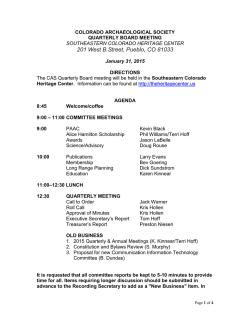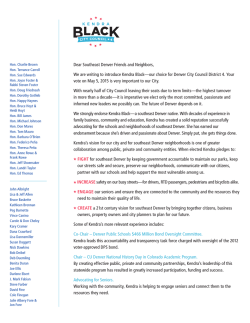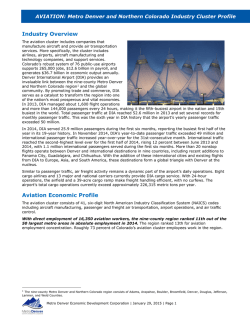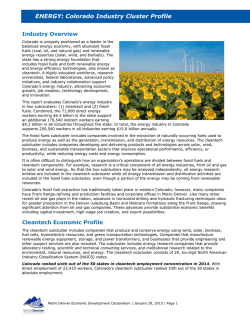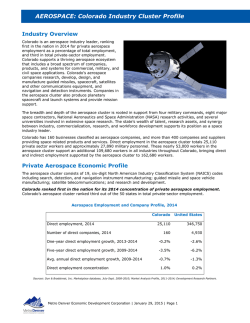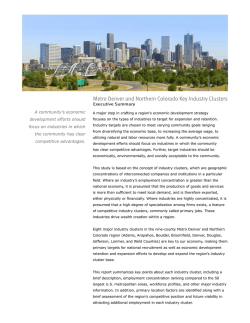
View File - Metro Denver Economic Development Corporation
BROADCASTING AND TELECOMMUNICATIONS: Metro Denver and Northern Colorado Industry Cluster Profile Industry Overview The broadcasting and telecommunications cluster includes companies that help deliver voice, data, and video to end users. This cluster includes landline and wireless telephone communications companies, radio and television communications services, and cable and Internet service providers. Broadband and mobile technologies have become more widely accessible business modes of communication for many nine-county Metro Denver and Northern Colorado 1 companies. The advancement of high-speed Internet connections has helped to increase the number of employees that telework or work at home while connected by information technology. The nine-county region is one of the nation’s top areas for teleworking due to the region’s expansive telecommunications infrastructure, the percentage of high-tech companies, innovative ecosystem, and vibrant workforce. According to the U.S. Census Bureau, Colorado ranked ninth among the 50 states for the largest percentage of individuals living in a home with a high-speed Internet subscription, five percent higher than the national average of 78 percent. The downtown Denver WiFi Zone was among the first in the nation to provide large-scale, public Internet access and several locations throughout Denver offer free WiFi, including the 16th Street Mall, Skyline Park, and Denver International Airport. The Denver Regional Council of Government’s Telework Colorado program offers free telework consulting services for employers in the region including information, materials, expert advice, and customized programs. A number of strategic initiatives are underway to expand Colorado’s broadband infrastructure. Colorado has a five-year strategic plan to enable statewide broadband connectivity by partnering with the private sector to assure availability to all Coloradans. Further, the Colorado Broadband Data and Development Program was created via a grant from the National Telecommunications and Information Administration for broadband mapping and planning. Colorado received funding to continue the assessment of broadband deployment across the state and engage in planning and outreach activities to promote broadband adoption. The nine-county region’s governments and local communities use digital technologies to enhance services, maximize efficiency, and expand information technology networks to better service their population and streamline operations. Douglas County ranked fifth in the 250,000 to 499,999 population category of the “2014 Digital Counties Survey.” The city of Denver ranked seventh in the more than 250,000 population category, the city of Fort Collins ranked seventh in the 125,000 to 249,999 population, and the cities of Boulder and Westminster ranked among the top five in the 75,000 to 124,999 population category in the “2014 Digital Cities Survey.” Both surveys, compiled by e.Republic’s Center for Digital Government and Digital Communities, recognized counties and cities that provided exemplary digital service to their residents and highlighted the areas’ best practices. Wireless and wired networks upgrades are enhancing speed, reliability, coverage, and performance for residents and businesses in the nine-county region. Since 2011, AT&T has invested nearly $550 million in wireless and wired networks across the state. Advancing its Project Velocity IP (VIP), an investment plan to expand and enhance its wireless and wired IP broadband networks, AT&T made 292 network upgrades in Colorado in 2013, including new cell sites, additional wireless network capacity, and new broadband network connections. Verizon Wireless launched faster mobile broadband technology in five Colorado cities and other nationwide markets. Denver, Colorado Springs, Fort Collins, Greeley, and Pueblo will have access to Verizon’s XLTE network, which will deliver faster peak data speeds and a minimum of double the bandwidth to fourth-generation mobile broadband, long-term evolution network, or 4G LTE customers in high-traffic areas. 1 The nine-county Metro Denver and Northern Colorado region consists of Adams, Arapahoe, Boulder, Broomfield, Denver, Douglas, Jefferson, Larimer, and Weld Counties. Metro Denver Economic Development Corporation | January 29, 2015 | Page 1 BROADCASTING AND TELECOMMUNICATIONS: Metro Denver and Northern Colorado Industry Cluster Profile Sprint launched its enhanced LTE network in Denver, with improved in-building signal, expanded coverage, and intelligence offered by the enhanced network capability. The LTE network offers customers wireless speeds of 6 to 15 megabits per second (Mbps), with peaks of 50 to 60 Mbps. Broadcasting and Telecommunications Economic Profile The broadcasting and telecommunications industry cluster consists of 16, six-digit North American Industry Classification System (NAICS) codes including radio and television communications equipment, telephone communications, and cable television services. The nine-county region ranked fifth out of the 50 largest metro areas for broadcasting and telecommunications employment concentration in 2014. With direct employment of about 42,810 broadcasting and telecommunications employees, the region ranked 10th in absolute employment. About 88 percent of Colorado’s broadcasting and telecommunications cluster employees work in the region. Broadcasting and Telecommunications Employment and Company Profile, 2014 Nine-County Region United States 42,810 1,223,200 Number of direct companies, 2014 2,490 142,160 One-year direct employment growth, 2013-2014 0.9% 1.1% Five-year direct employment growth, 2009-2014 0.0% -8.9% Avg. annual direct employment growth, 2009-2014 0.0% -1.9% Direct employment concentration 2.3% 0.8% Direct employment, 2014 Sources: Dun & Bradstreet, Inc. Marketplace database, July-Sept. 2008-2010; Market Analysis Profile, 2011-2014; Development Research Partners. Broadcasting and Telecommunications Employment The nine-county region’s broadcasting and telecommunications employment (42,810 workers) rose 0.9 percent in 2014, compared with the previous year’s level, adding nearly 370 new jobs over the same period. National employment levels increased 1.1 percent over-the-year. About 3.5 percent of the nation’s broadcasting and telecommunications employment is located in the region. Approximately 2,490 broadcasting and telecommunications companies operated in the nine-county region in 2014. About 78 percent of the region’s broadcasting and telecommunications companies employed fewer than 10 people, while 0.9 percent employed 250 or more. Broadcasting and Telecommunications Number of Employees Growth Rate 5% 0% -5% -10% 2009 2010 2011 2012 Nine-County Region 2013 2014 Avg Annual Growth United States Source: Dun & Bradstreet, Inc., Marketplace database, July-Sept. 2008-2010; Market Analysis Profile, 2011-2014. Metro Denver Economic Development Corporation | January 29, 2015 | Page 2 BROADCASTING AND TELECOMMUNICATIONS: Metro Denver and Northern Colorado Industry Cluster Profile Broadcasting & Telecommunications Employment by County, 2014 Larimer 3.1% Arapahoe 33% Weld 0.8% Adams 3.8% Jefferson 4.8% Boulder 5.8% Broomfield 6.0% Denver 29% Douglas 13% Sources: Market Analysis Profile, 2014; Development Research Partners. Broadcasting & Telecommunications Employment by Industry Sector, 2014 Communications equipment mfg. Radio & 3.9% television broadcasting stations 4.6% Telephone communication services 49.3% Information retrieval services 5.5% Other communication services 7.7% Cable & other pay television services 28.9% Sources: Market Analysis Profile, 2014; Development Research Partners. Major Broadcasting and Telecommunications Companies • Alcatel-Lucent www.alcatel-lucent.com • iHeartMedia, Inc. (formerly Clear Channel Comm., Inc.) • AT&T Inc. www.att.com • Integra Telecom, Inc. www.integratelecom.com • Avaya Inc. www.avaya.com • Jones International, Ltd. www.jones.com • BI Incorporated http://bi.com • Level 3 Communications, Inc. www.level3.com • Birch Communications www.birch.com • Liberty Media Corp. www.libertymedia.com • BT Conferencing, Inc. www.btconferencing.com • Sprint Corp. www.sprint.com • CenturyLink, Inc. www.centurylink.com • Starz www.starz.com • Charter Communications Inc. www.charter.com • T-Mobile www.t-mobile.com Metro Denver Economic Development Corporation | January 29, 2015 | Page 3 BROADCASTING AND TELECOMMUNICATIONS: Metro Denver and Northern Colorado Industry Cluster Profile Major Broadcasting and Telecommunications Companies Cont’d • Comcast Corp. www.comcast.com • Verizon www.verizon.com • DIRECTV, Inc. www.directv.com • XO Communications, LLC www.xo.com • DISH Network www.dishnetwork.com • WildBlue Communications, Inc. www.wildblue.com • EchoStar Corp. www.echostar.com • Zayo Group www.zayo.com • Google www.google.com 2014 Industry Highlights Expanded Broadband and Network Improvements The nine-county region’s broadcasting and telecommunications companies offered expanded broadband and increased network speeds in 2014. • • • • • CenturyLink, Inc. expanded its Internet television service in the region to Douglas County, unincorporated Jefferson County, Denver, Centennial, and Castle Rock. CenturyLink, Inc.’s television service Prism™ was first offered to residents in Highlands Ranch and is delivered through the company’s fiber-optic network. CenturyLink began offering Internet speeds of 1 gigabit per second to its Metro Denver customers. The upgraded speed will allow users to stream high-definition video, download movies, songs, and shows in seconds and is up to 100 times faster than the 10 Mbps or less that is the national average. Comcast Corp. and Englewood-based Liberty Global PLC formed an agreement to offer the industry’s first international WiFi roaming connectivity to their subscribers. The service will be offered beginning in 2015 and will allow subscribers to access each other’s WiFi networks without consuming allotted data on their wireless plans. Comcast Corp. doubled its two most popular Internet speed plans in Colorado for no additional cost. The Blast! Plan increased download speeds from up to 25 Mbps to up to 50 Mbps, Extreme 50 increased download speeds from up to 50 Mbps to up to 105 Mbps, and the Performance plan increased speeds from 15 Mbps to up to 20 Mbps. Douglas County-based DISH Network signed an agreement with The Walt Disney Company to provide DISH customers with access to Disney’s sports, news, and entertainment content across Internet devices. Under the agreement, DISH customers can access Disney’s authenticated live and video-on-demand products. Key Company Announcements The nine-county region is a key location for broadcasting and telecommunication companies to grow and expand. Notable company announcements in 2014 included: • • • • Layer3 TV relocated its headquarters from Boston to downtown Denver. The company provides IP video and technology and could generate 312 jobs over the next few years. Google plans to build a four-acre campus in Boulder, which includes three, four-story buildings at 30th and Pearl Streets. The expansion includes a 600-space underground parking garage, 300 spaces for bicycles, and enough space for up to 1,500 employees. The company’s Boulder workforce of 340 employees are dispersed throughout the city and would be consolidated into the site in early 2017. ViaWest opened their newest greenfield data center in a 200,000-plus-square-foot building in Metro Denver. The data center is located south of Centennial Airport near E-470 and Peoria. The $208 million facility contains 140,000 square feet of raised floor dedicated to data servers and the company plans to invest $316 million over the next seven years. Charter Communications Inc. broke ground on a $25.5 million research and development facility at the Compark Business Campus in unincorporated Douglas County. The 85,000-square-foot industrial building will include 60,000 square feet of office space, conference rooms, and break areas, and the Metro Denver Economic Development Corporation | January 29, 2015 | Page 4 BROADCASTING AND TELECOMMUNICATIONS: Metro Denver and Northern Colorado Industry Cluster Profile • • residual space will include a data center laboratory. The new facility will accommodate more than 200 technical staff and is slated for completion in 2015. Avaya Inc. relocated its laboratory operations from Westminster to Thornton and will move its Westminster-based services business to Highlands Ranch. The new 116,000 square feet of space in Thornton includes infrastructure upgrades, additional parking, and landscaping upgrades. Boulder-based Zayo Group LLC opened a 24,000-square-foot facility in downtown Denver. The new office near Denver’s Union Station will house about 125 employees. Merger and Acquisition Activity Companies in the nine-county region announced several mergers and acquisitions in 2014. • • • • Douglas County-based tw telecom was purchased by Broomfield-based Level 3 Communications, Inc. The $5.3 billion deal will add business and local fiber-optic rings in 76 U.S. metropolitan areas and improve data carrying capacity. The deal increased Level 3’s international fiber-optic network to 212,000 miles, which carries Internet traffic, video, and business data for client companies. The combined companies have nearly 4,000 Colorado employees and 13,600 worldwide. Imagine Communications, a media technology business that was formerly part of Colorado-based Harris Broadcast, acquired OpenTV’s Advanced Advertising business unit. The company will add more than 75 developers, research and development staff, and customer service representatives to Imagine’s Denver and California facilities. Greenwood Village-based ViaWest Inc. was sold to Canadian cable multiple-system operator Shaw Communications Inc. The $1.2 billion deal will expand Shaw’s data service offerings and cloud capabilities business, while boosting ViaWest’s company operations in North America. ViaWest’s headquarters will remain in Greenwood Village. Zayo Group acquired three companies including Paris-based Neo Telecoms, London-based Geo Networks Ltd., and Dallas, Texas-based CoreXchange, Inc. The acquisitions will add more than 2,100 miles to its existing fiber-optic network in Europe and will bring Zayo’s total data center count to 27 locations across the U.S. Cross-Cluster Convergence The nine-county region’s unique convergence of broadcasting and telecommunications and other high-tech industries, such as aviation and aerospace, provides further opportunities for innovation, collaboration, and growth. • • Broomfield-based Gogo Biz launched its in-flight WiFi and voice services for business jets flying over Canada. The offering is the largest territorial expansion the company has undergone since launching its service in 2009. The company’s Gogo service is the dominant domestic in-flight WiFi for 2,300 domestic planes operated by Delta Airlines, American Airlines, US Airways, United Airlines, Frontier Airlines, and AirTran Airways. Northrop Grumman Corp. selected Broomfield-based Level 3 Communications Inc. to deliver images and communications via its network to a national simulation training system for the U.S. Air Force. Under the agreement, Level 3 will deliver real-time communications and high-resolution images for the simulations. Research and Educational Announcements The nine-county region’s leading research institutions and educational facilities make significant contributions to the region’s broadcasting and telecommunications industry. • • The University of Colorado approved the new College of Media, Communication, and Information. The majors offered include media design, advertising, communication, information, and science and media studies. College enrollment will begin in the fall of 2015. Colorado State University partnered with Indiana University, the University of Michigan, the University of Florida, and the University of Wisconsin‐Madison to improve the way digital educational content is shared across universities and delivered to students. The technology consortium launched a new online platform, Unizin, as a one‐stop shop for digital education that allows faculty to design effective learning experiences and improve how course content is created and delivered to students. Metro Denver Economic Development Corporation | January 29, 2015 | Page 5 BROADCASTING AND TELECOMMUNICATIONS: Metro Denver and Northern Colorado Industry Cluster Profile Broadcasting and Telecommunications Workforce Profile Many companies choose locations because of the available workforce. With nearly half of the nine-county region’s 3.6 million residents under the age of 35, employers can draw from a large, young, highly educated, and productive workforce. Of the region’s adult population, 41.2 percent are college graduates and 90.5 percent have graduated from high school. The state has the nation’s second-most highly educated workforce as measured by the percentage of residents with a bachelor’s degree or higher. The attractiveness of the region draws new residents through migration. The region’s population is expected to grow 53.3 percent from 2010 to 2040, driving a 36.3 percent increase in the region’s labor force over the same period. It is important to note the changing composition of the workforce supply as the baby boomers begin to retire, which will pose implications for businesses whose employee pool includes significant numbers of these workers. Educational Attainment of Metro Denver and Northern Colorado's Population Age 25 and Older Less than 9th Grade 3.9% Graduate or Professional Degree 15.3% 9th to 12th Grade, No Diploma 5.6% High School Graduate (includes equivalency) 20.0% Bachelor’s Degree 25.9% Some College, No Degree 21.7% Associate Degree 7.7% Source: U.S. Census Bureau, 2013 American Community Survey. 3,000,000 Metro Denver and Northern Colorado's Labor Force Projections by Age 2,500,000 2,000,000 The nine-county region’s broadcasting and telecommunications industry employs 42,810 people and includes a large pool of talented, well-educated, and highly skilled workers. Compared with the age distribution across all industries, the broadcasting and telecommunications cluster has a larger share of employees that are between the ages of 25 and 54 years old. 1,500,000 1,000,000 500,000 0 2010 2020 16-24 25-34 2030 35-44 45-54 2040 55-64 65+ Source: Colorado Division of Local Government, State Demography Office. The broadcasting and telecommunications workforce supply consists of four main components: those currently working in the industry; those doing a similar type of job in some other industry; the unemployed; and those currently in the education pipeline. The Metro Denver and Northern Colorado Occupation & Salary Profile below includes the 10 largest broadcasting and telecommunications occupations in the region. For these 10 largest occupations, the chart details the total number of workers employed in that occupation across all industries, the number of available applicants that would like to be working in that occupation, the number of recent graduates that are qualified for that occupation, and the median and sample percentile annual salaries. Metro Denver and Northern Colorado's Distribution of Employment by Age 35% 30% 25% 20% 15% 10% 5% 0% 16-24 25-34 35-44 45-54 Broadcasting & Telecommunications 55-64 65+ All Industries Source: Provided by Arapahoe/Douglas Works! QCEW Employees, Non-QCEW Employees, Self Employed, & Extended Proprietors - EMSI 2014.3 Class of Worker. Metro Denver Economic Development Corporation | January 29, 2015 | Page 6 BROADCASTING AND TELECOMMUNICATIONS: Metro Denver and Northern Colorado Industry Cluster Profile Wages The 2013 average annual salary for broadcasting and telecommunications employees in the nine-county region was $97,700, compared with $80,110 nationwide. Total payroll for the broadcasting and telecommunications cluster in the region exceeded $4.1 billion in 2013. Metro Denver and Northern Colorado Broadcasting and Telecommunications Occupation & Salary Profile, 2014 10 Largest Broadcasting & Telecommunications Occupations in Metro Denver and Northern Colorado 1. Customer service representatives 2. Telecommunications equipment installers & repairers, except line installers 3. Sales representatives, services, all other 4. Business operations specialists, all other 5. Electronics engineers, except computer 6. Network & computer systems administrators 7. Software developers, applications 8. Software developers, systems software 9. Computer network architects 10. Secretaries & administrative assistants, except legal, medical, & executive Total Working Number of Across All Available Industries Applicants (2014) (2014) Number of Graduates (2013) Median Salary 10th Percentile Salary 25th Percentile Salary 75th 90th Percentile Percentile Salary Salary 36,610 6,494 0 $31,866 $22,194 $26,562 $40,290 $49,754 3,731 201 9 $63,523 $39,166 $53,082 $69,742 $73,653 17,631 1,286 77 $50,877 $24,960 $34,674 $75,546 $110,864 32,981 789 77 $69,930 $36,067 $50,024 $92,622 $120,078 4,292 86 356 $92,955 $59,634 $72,758 $119,246 $144,352 8,567 523 696 $78,312 $50,835 $62,816 $95,389 $113,214 19,382 340 585 $91,021 $56,056 $71,718 $111,696 $134,472 10,055 105 630 $97,136 $64,210 $78,915 $118,685 $140,878 3,091 95 1,552 $96,720 $49,442 $72,821 $115,440 $138,674 49,635 654 71 $36,026 $23,587 $29,037 $43,992 $51,979 Notes: The number of available applicants is a point-in-time measurement of the number of people who have registered in Colorado’s workforce development system’s statewide database, Connecting Colorado, as being able and available to work in a particular occupation. Results should be interpreted with caution since registration in Connecting Colorado is self-reported. In addition, the skills rubric may assign up to four occupation codes for each registrant. Therefore, the number of available applicants could be inflated. Source: Provided by Arapahoe/Douglas Works!; QCEW Employees, Non-QCEW Employees, Self Employed, & Extended Proprietors - EMSI 2014.3 Class of Worker. Education & Training Colorado’s higher education system provides an excellent support system for businesses in the region. There are 28 public higher education institutions in Colorado, of which seven four‐year and six two‐year public institutions offering comprehensive curricula are located in the nine‐county region. In addition, there are more than 100 private and religious accredited institutions and nearly 340 private occupational and technical schools offering courses in dozens of program areas throughout the state. Although not exhaustive, a list of the major, accredited educational institutions with the greatest number of graduates for each of the 10 largest broadcasting and telecommunications occupations in the nine-county region are included below. A directory of all higher education institutions with corresponding websites may be accessed via http://highered.colorado.gov. Metro Denver Economic Development Corporation | January 29, 2015 | Page 7 BROADCASTING AND TELECOMMUNICATIONS: Metro Denver and Northern Colorado Industry Cluster Profile • Colorado State University www.colostate.edu • Metropolitan State University of Denver www.msudenver.edu • University of Denver www.du.edu • Colorado State University Global Campus www.colostate.edu • Regis University www.regis.edu • University of Northern Colorado www.unco.edu • DeVry University – Colorado www.devry.edu • University of Colorado Boulder www.colorado.edu • Jones International University www.jiu.edu • University of Colorado Denver www.ucdenver.edu Key Reasons for Broadcasting and Telecommunications Companies to Locate in the Nine-County Region The region is a top 10 broadcasting and telecommunications location offering: 1. A central location and easy global access • Metro Denver's unique geographic location in the Mountain time zone makes it the largest region in the U.S. to offer one-bounce satellite uplinks. This capability provides companies with real-time connections to six of seven continents in one business day. (Metro Denver Economic Development Corporation) • Denver International Airport was the fifth-busiest airport in the nation and 15th-busiest worldwide in terms of passenger traffic in 2013. (U.S. Bureau of Transportation Statistics, 2014; Airports Council International 2014; and Denver International Airport, 2014) • Located on the 105th meridian, the nine-county region’s central location at the exact midpoint between Tokyo and Frankfurt positions the region favorably to serve growing world markets. The region is an excellent location for doing business with the entire nation and is within four hours flying time of every North American city with a population of 1 million or more. (Metro Denver Economic Development Corporation) • Denver ranked among the top-five safest cities for natural disasters in 2014. (HomeownersInsurance.com, 2014) 2. A large concentration of high-quality technology workers and entrepreneurial talent • Of Colorado’s adult population, nearly 38 percent has completed a bachelor’s or higher-level degree, making Colorado the second-most highly educated state in the nation behind Massachusetts. (U.S. Census Bureau, 2013 American Community Survey) • Colorado had the third-highest tech-worker concentration in 2012, with 8.7 percent of the state’s private-sector workforce employed in technology firms. Colorado also had the nation’s 11th-largest employment base in the Internet and telecommunications services industry and ranked sixth for average high-tech wage, 11th for absolute number of high-tech businesses, and 15th for absolute employment in the high-tech industry. Colorado tech workers earn 98 percent more than the average private sector worker. (TechAmerica Foundation, Cyberstates 2013: The Definitive State-by-State Analysis of the U.S. High-Technology Industry, 2013) • Colorado ranked as the fifth-most entrepreneurial state in the 2013 Kauffman Index of Entrepreneurial Activity, with 380 new business owners per 100,000 adults. (Ewing Marion Kauffman Foundation, 2014) • Denver ranked as the second-best city to launch a startup business out of the 50 most populated cities. (Forbes, 2014) • Technology workers in the Denver-Boulder area had the third-highest salaries in the U.S. in 2014. Adjusted for cost of living, the average annual salary for the Denver-Boulder area’s technology workforce was $98,000. (TriNet, 2014) • Denver ranked as the ninth-best city for college graduates and received accolades for its highly educated population, moderate cost of living, and higher-than-average wages. (NerdWallet, 2014) • Denver ranked as the seventh-best city for millennials (ages 25-34) out of 25 major cities with a population over 1 million in 2014. (Niche.com, 2014) Metro Denver Economic Development Corporation | January 29, 2015 | Page 8 BROADCASTING AND TELECOMMUNICATIONS: Metro Denver and Northern Colorado Industry Cluster Profile • The Denver-Aurora-Broomfield MSA was named to the top 10 list of “Best Big Cities for Jobs 2014.” (Forbes, 2014) 3. Low to moderate costs of doing business • Forbes ranked Colorado fifth on its 2014 “Best States for Business and Careers” list. The state received its highest rankings for labor supply (first overall), growth prospects (fourth overall), economic climate (eighth overall), and quality of life (ninth overall). (Forbes, 2014) • Metro Denver ranked fourth among Forbes 2014 “Best Places for Business and Careers” list. Four other Colorado metropolitan areas were included on the list. The Fort Collins metro area ranked fifth overall, Greeley ranked 20th, Boulder ranked 23rd, and Colorado Springs ranked 29th. (Forbes, 2014) • Metro Denver office rental rates averaged $28.83 per square foot in the fourth quarter of 2014, making the region’s office market highly competitive with other major markets in the U.S. (CoStar Realty Information, The CoStar Office Report, Q4 2014) 4. A pro-business environment and competitive tax structure • Colorado's simplified corporate income tax structure based on single-factor apportionment allows companies to pay taxes based solely on their sales in the state. Along with few regulatory burdens, Colorado's corporate income tax rate of 4.63 percent is one of the lowest and most competitive tax structures in the nation. (State of Colorado; The Tax Foundation) • Colorado has the nation’s ninth-best tax climate for entrepreneurship and small business. (Small Business & Entrepreneurship Council, 2014) • Colorado ranked second in innovation and entrepreneurship and was among the top 10 states for infrastructure, business climate, and talent pipeline. (National Chamber Foundation, 2014) • Colorado ranked as the No. 8 small-business-friendly state in the nation. Fort Collins (24th) and Denver (28th) ranked among 84 cities in the country. (Thumbtack.com, 2014; Ewing Marion Kauffman Foundation, 2014) 5. An overall better quality of life • Castle Rock ranked fourth in MONEY Magazine’s 2014 list of the “Best Places to Live.” Centennial (13th) and Boulder (23rd) were also named to the list’s top 50. (MONEY Magazine, 2014) • Metro Denver ranked as the fourth-fittest metro area in the nation in 2014. Denver’s high percentage of residents participating in physical activity, and low obesity and cardiovascular disease rates contributed to its high rank. (American College of Sports Medicine, 2014) • Colorado has the fourth-highest percentage of state land area devoted to the National Forest System. The state offers access to more than 50 national parks and wilderness areas, 42 state parks, and the greatest number of 14,000-foot peaks in the nation that support a healthy, active lifestyle. (U.S. Forest Service, 2014; Colorado State Parks, 2014) • Boulder ranked second on the 2014 list of the “Top 100 Best Places to Live.” Aurora (50th) and Lakewood (88th) were also named to the list. (Livability.com, 2014) • FasTracks, a comprehensive project to build out Metro Denver’s entire mass transit system by 2019, is the largest simultaneous transit buildout in U.S. history. The expansion will make Metro Denver one of the top five regions in the country in terms of miles of fixed rail. Metro Denver Economic Development Corporation | January 29, 2015 | Page 9 BROADCASTING AND TELECOMMUNICATIONS: Metro Denver and Northern Colorado Industry Cluster Profile Broadcasting and Telecommunications Industry Cluster Definition NAICS Code* 334210 334220 (P) NAICS Description Telephone apparatus mfg. Radio & television broadcasting & wireless communications equipment mfg. Other communications equipment mfg. Fiber optic cable mfg. SIC Code 3661 3663 Other communication & energy wire mfg. 3357 515111 515112 515120 515210 Radio networks Radio stations Television broadcasting Cable networks & other subscription prog. 4832 4832 4833 4841 517110 Wired telecommunications carriers 4813 517110 517110 Wired telecommunications carriers Wired telecommunications carriers 4822 4841 517110 517210 Wired telecommunications carriers Wireless telecommunications carriers (except satellite) Wireless telecommunications carriers (except satellite) Wireless telecommunications carriers (except satellite) Satellite telecommunications Telecommunications resellers Telecommunications resellers 7375 4812 SIC Description Telephone & telegraph apparatus Radio & tv communications equipment Communications equipment, NEC Drawing & insulating of nonferrous wire Drawing & insulating of nonferrous wire Radio broadcasting stations Radio broadcasting stations Television broadcasting stations Cable & other pay television services Telephone communication except radio Telegraph & other communications Cable & other pay television services Information retrieval services Radiotelephone communication 4899 Communication services, NEC 7375 Information retrieval services 4899 4812 4813 All other telecommunications All other telecommunications Internet publishing & broadcasting & web search portals All other business support services 4899 7375 8999-0800 Communication services, NEC Radiotelephone communication Telephone communication except radio Communication services, NEC Information retrieval services Communication services 7389-1004 Teleconferencing services 334290 335921 335929 (P) 517210 517210 517410 517911 517911 517919 517919 519130 (P) (P) (P) 561499 (P) 3669 3357 *(P) indicates that only part of the NAICS industry category is represented in the industry cluster definition. Note: NEC indicates “not elsewhere classified.” Metro Denver Economic Development Corporation | January 29, 2015 | Page 10 BROADCASTING AND TELECOMMUNICATIONS: Metro Denver and Northern Colorado Industry Cluster Profile Broadcasting and Telecommunications Industry Cluster Relationships Technologies Wi-Fi – Wireless Fidelity Fiber Optic Networks VoIP – Voice over Internet Protocol Nanotechnology Internet Photonics Client Industries Support Industries Aerospace Computer Storage Fiber Optics Geospatial Photonics Software Broadcasting and Telecommunications Infrastructure Aerospace Aviation Bioscience Energy Financial Services Healthcare Software Consumers Businesses CO Technology Partners One-Bounce Satellite Location High-Speed Digital Network CO Telecom Association CO Photonics Industry Association CU-Telecom Systems Lab CTA-Colorado Technology Association DU Center for Technology Innovation For additional information, contact us: 1445 Market Street Denver, CO 80202-1790 303.620.8092 email: [email protected] www.metrodenver.org Prepared by Development Research Partners, Inc., www.DevelopmentResearch.net Metro Denver Economic Development Corporation | January 29, 2015 | Page 11
© Copyright 2024

